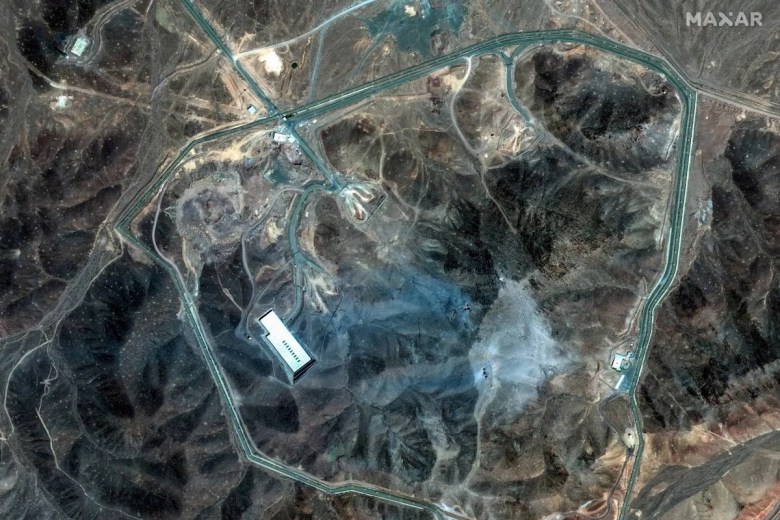Science
New Study Reveals Extensive Damage at Iran’s Fordow Nuclear Site

A recent study employing advanced sensing technology has confirmed extensive damage to the Fordow Nuclear Facility in Iran following a military strike. On June 22, 2025, the United States conducted “Operation Midnight Hammer,” targeting the facility, which is located near the city of Qom. The analysis utilized hyperspectral imaging from the Global Hyperspectral Observation Satellite constellation (GHOSt) to assess the impact of the strike.
The Fordow facility, officially known as the Shahid Ali Mohammadi Nuclear Facility, is situated deep within a mountain, making it particularly resistant to conventional airstrikes. Despite its fortified location, the U.S. attack, reportedly utilizing B-2 Spirit stealth bombers and GBU-57 bombs, inflicted significant damage. These bombs, designed to penetrate hardened underground structures, were aimed at the facility’s ventilation shafts.
Advanced Imaging Technology Confirms Damage
Analysis by Orbital Sidekick (OSK), a San Francisco-based aerospace company, employed hyperspectral imaging to evaluate the aftermath of the strike. The imaging revealed that multiple blasts caused subsidence over an area of approximately 315 meters by 275 meters, indicating potential collapse of underground halls and centrifuge complexes.
OSK’s assessment, dubbed “Fingerprinting the Invisible,” led to the identification of three types of concrete used in the Fordow complex. The findings suggest that the facility sustained “extremely severe damage,” with some reports indicating that it may have been totally destroyed. U.S. officials have varied in their assessments, with some claiming the site was “totally obliterated,” while others suggest the damage will only delay Iran’s nuclear ambitions by a few months.
The Fordow facility has been a significant point of concern for international security, as it has been used for high levels of uranium enrichment, including up to 60%. Inspectors have detected traces of uranium enriched to 83.7% purity, nearing the threshold for weapons-grade material.
The Evolution of Earth Observation Technology
The ability to monitor military developments through satellite technology has evolved significantly since the launch of the Landsat system in 1972. Initially designed for Earth resource observation, Landsat has provided critical data for various applications, including environmental monitoring and disaster assessment. The latest advancement, the GHOSt constellation, enhances this capability by offering hyperspectral imaging, which provides detailed analysis across multiple wavelengths beyond visible light.
OSK’s hyperspectral sensors have applications that extend beyond military use, including agricultural assessments and infrastructure monitoring. This dual-use nature of technology raises concerns about its accessibility to potential adversaries, who may leverage similar capabilities for their own strategic purposes.
The findings from the Fordow analysis highlight the transformative impact of advanced imaging technologies on modern warfare and intelligence gathering. As these capabilities become more widely available, the implications for global security dynamics will be profound.
As the situation develops, the ongoing assessment of the Fordow facility will remain critical in understanding the future trajectory of Iran’s nuclear program and the broader geopolitical landscape in the region.
-

 Business5 months ago
Business5 months agoKenvue Dismisses CEO Thibaut Mongon as Strategic Review Advances
-

 Lifestyle4 months ago
Lifestyle4 months agoHumanism Camp Engages 250 Youths in Summer Fest 2025
-

 Sports4 months ago
Sports4 months agoDe Minaur Triumphs at Washington Open After Thrilling Comeback
-

 Sports5 months ago
Sports5 months agoTupou and Daugunu Join First Nations Squad for Lions Clash
-

 Top Stories5 months ago
Top Stories5 months agoColombian Senator Miguel Uribe Shows Signs of Recovery After Attack
-

 World5 months ago
World5 months agoASEAN Gears Up for Historic Joint Meeting of Foreign and Economic Ministers
-

 Health4 months ago
Health4 months agoNew Study Challenges Assumptions About Aging and Inflammation
-

 Business5 months ago
Business5 months agoOil Prices Surge Following New EU Sanctions on Russia
-

 Entertainment4 months ago
Entertainment4 months agoDetaşe-Sabah Violin Ensemble Captivates at Gabala Music Festival
-

 Entertainment4 months ago
Entertainment4 months agoBaku Metro Extends Hours for Justin Timberlake Concert
-

 Top Stories5 months ago
Top Stories5 months agoRethinking Singapore’s F&B Regulations Amid Business Closures
-

 Business5 months ago
Business5 months agoU.S. House Approves Stablecoin Bill, Sends to Trump for Signature









